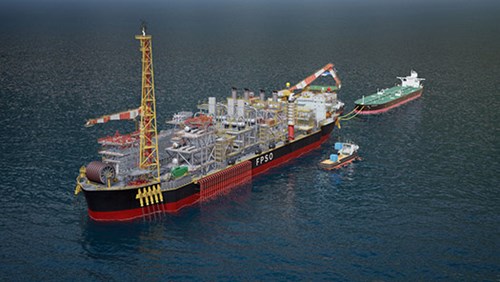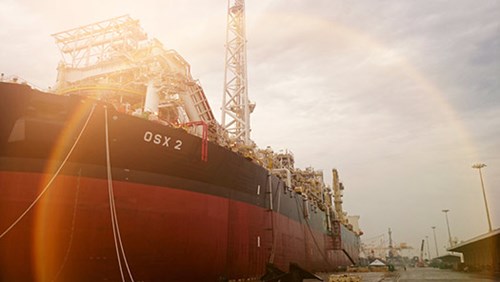How to digitalize sustainability in FPSO production
As the oil and gas industry has responded to increased pressure to improve its environmental performance, one segment that has faced unique challenges in its efforts to be more sustainable is floating production. The same factors that complicate production on floating production, storage, and offloading (FPSO) vessels can also hinder sustainability efforts. Sea conditions, weather events and the remoteness of the vessels all create potential risks for containment loss and worker safety. Also, while every aspect of a floating vessel’s operation can impact sustainability, the process used to design and build a vessel is typically more focused on a different priority—getting the vessel built and operating at the lowest possible cost.
Digital technologies can give you better insights into energy usage and emissions across your vessel’s processes. And they can help staff make better decisions to reduce containment and safety risks. But in order to make meaningful improvements that will help you achieve your sustainability goals, digitalization can’t be an afterthought. It should be built into your vessel’s design and address your vessel’s near- and long-term sustainability targets.
Addressing your risks. An OpenWater Energy analysis of a typical FPSO found that the top sources of CO2 emissions were gas compression (36%), general power (23%), water injection (20%), inert gas (12%), flared gas (5%) and fugitive emissions (4%). And even the less substantial emissions sources can have a significant impact on the environment and your bottom line. Flared gases are a prime example. According to Capterio, FPSOs today contribute 540 MMcfd of flared gas. That represents 4% of all global flaring and 21% of all offshore flaring—and nearly $1 billion of potential revenue per year.
REDUCING EMISSIONS
A digitalized connected vessel approach to risk assessment can help you better understand and improve your performance across emissions risk areas. Consider these three examples:
Energy measurement. Energy management is important on FPSOs, given how much hydrocarbon flows through the vessel and the various utilities required for the production and processing of the oil and gas streams, Fig. 1. Understanding your energy balance can give you insights into the sustainability and profitability of the vessel. But first, you need to be able to measure what’s going in versus coming out of your vessel. Only then can you begin to understand what’s happening within the process itself and start to identify opportunities for improvement.

FIG. 1. Understanding an FPSO’s energy requirements can improve profitability and provide insights into the vessel’s sustainability potential.
Digital energy-management tools can help teams understand and optimize a vessel’s energy usage. The tools can provide trending data on the consumption and intensity of water, air, gas, electricity and steam (WAGES) on a vessel, and do so in the context of what’s happening with production.
Using pre-built and customizable dashboards, the tools can help make sure the right people get the right information. For instance, onboard staff may want to view energy consumption and energy intensity information for each utility to identify areas for optimization. On the other hand, onshore teams may need different information, like weekly WAGES trend reports or energy cost calculations and monitoring data. With the proper investment in instrumentation and digital infrastructure, raw process data can be transformed into useful information via these digital tools.
Carbon capture and storage processes can help you meet aggressive goals for reducing emissions. But as is true with energy management, better carbon capture and storage begins with better carbon accounting.
As some FPSO operators already know, getting detailed and accurate emissions data can be a complicated process. Flare analysis, for instance, can be elusive, because the precise oil and gas mixture coming out of a flare stack is difficult to measure. This is where an advanced emissions management solution can be helpful. It can combine artificial intelligence (AI), advanced analytics and physical property modeling to produce more accurate emissions measurements. These solutions can collect measurements for energy and emissions inventory and perform flare analysis to derive energy usage and predict emissions from the process. With these insights, carbon accounting can be improved, and staff can potentially make operational changes to reduce a vessel’s emissions and energy usage.
Insights from the tool can help staff uncover ways to improve or smooth out start-up operations. Analytics can help guide when operators should intervene or even trigger automatic optimization to help reduce energy and emissions in near-real time. And asset efficiency calculations can be used to implement predictive maintenance activities that can save you time, money, effort and energy.
Throughput. Keeping your vessel running at optimal conditions and achieving a process balance across multiple liquid and gas streams can help you better manage energy and emissions. An intelligent throughput optimization tool can help you achieve this by bringing real-time process engineering to your vessel’s control systems. Through a managed process relationship to the phase envelope, the tool can provide greater insights into process operation and help specify the minimum necessary additives for hydrate formation, benzene freezing and other hazards. And by giving you a process balance and prediction of emissions, the tool can help staff change operations, based on those results. For example, they can address cycle times and operate closer to control limits.
These three use cases and the technologies associated with them may not yet be able to eliminate all containment risk from your FPSO operations. But by helping you monitor, control and optimize vessel operations—or even reimagine what operations can be—they have the potential to drastically reduce the threat of containment loss and optimize vessel safety.
DIGITALIZATION STRATEGY
Whether you’re in the planning stages of a new floating production vessel or looking to improve the sustainability of an existing vessel, four elements should be at the core of your digitalization strategy.
First, accurate data. Your ability to monitor, report and ultimately optimize hydrocarbon containment on your vessel hinges on having timely and accurate data, Fig. 2. This means using smart instruments to track advanced vessel operations in real time. Too often, vessels are only instrumented for stable operations, not for advanced applications or operations. But adding smart instruments to a vessel at any point after the design or build phase can be cost-prohibitive, potentially jeopardizing your digital sustainability efforts. Along with good data, you also need data science capabilities in place to help discern data quality, such as by monitoring instrument health or comparing the before and after data points around an instrument.

FIG. 2. Using smart instruments to track vessel operations in real time enables engineers to monitor, report and ultimately optimize hydrocarbon containment.
Second, a digital infrastructure. An open, digital infrastructure allows data to flow freely across your vessel’s systems without requiring customized connectors. And it allows you to use your preferred mix of application solutions instead of being locked into using one supplier’s tools.
Your infrastructure should also be flexible to support new technologies, as they become available. FPSOs are expected to operate for 20 to 25 years. It’s difficult to comprehend how digital technologies will further transform oil and gas operations in 2040 and beyond—but your vessel should be ready to use them. When it comes to what solutions should be built into your digital infrastructure today, advanced analytics and remote-connectivity capabilities are essential. They can help staff not only see data but also make sense of it, whether they’re in the vessel’s control room, at an onshore support center or accessing information from somewhere else as a subject matter expert.
Disruptive technologies like AI can also be a difference-maker, helping operators predict events like process upsets to help reduce flaring and other containment losses. And they can help you adopt predictive maintenance strategies to keep vessel assets running at optimal efficiency.
In addition, constructing newer vessels with modern modular automation standards in mind will better position vessel operators to upgrade future systems. Industry leaders are working to implement a set of modular automation system guidelines known as the module type package standard. The purpose of this standard is to help FPSO operators lower implementation and upgrade costs over a vessel's lifecycle, while also allowing for improved interoperability with OEM-supplied automation features in different modules. Having this flexibility will help FPSO operators to upgrade vessels with sustainability goals in mind.
Third, the correct workflows. They’re sometimes overlooked, but accurate workflows should always be a critical aspect of your sustainability strategy. Why? Because data and insights only have value, if they’re reaching the right people. Vessel workflows should align with your technology—and even be developed in tandem with your vessel’s digital applications. Make sure that staff is getting actionable, relevant insights, so that they can interpret quality data and apply their insights across vessel operations.
The current generation entering the workforce will likely welcome the blending of digital technology into their jobs, because it’s already woven into their daily lives. However, seasoned workers may be resistant to new technologies telling them how to operate equipment that they’ve been running for several years. Activities like change-management plans and executive sponsorship can help break down any barriers to change as you roll out new workflows.
TRAINING
More than merely reading data, staff must be able to act on it, too. Training programs should be designed to help vessel staff know what to do with the information they’re getting, such as what changes they may need to make to process operations. Staff should also understand the information well enough to know if the changes they’re making are having a positive or negative impact on vessel operations and sustainability.
Of course, robust cybersecurity must be woven into all four of these elements. It can’t be an overlay or patched in—it must be addressed from the very beginning, at the conceptual phase. Similar to the suggested approach to digital technologies, “cybersecurity by design” is a critical concept to be adopted for all new floating production projects, taking into account the latest international standards and best practices.
OPERATIONAL BALANCE
An inevitable question when discussing digital sustainability is, how do you achieve your sustainability goals without a trade-off in your productivity goals? Often, the efforts required to minimize containment loss and safety risks are seen as conflicting with the efforts required to maximize production and reduce operating and maintenance costs.
But with a connected vessel strategy, you can address both your production and sustainability objectives. You don’t need to pick one over the other. There’s maybe no better example of how you can support both sets of goals at once than with a connected workforce. A connected vessel empowers both onboard and onshore workers by connecting them to data-based insights, digital tools and each other. This can simultaneously benefit your vessel’s sustainability and productivity.
For instance, insights into machine performance from advanced analytics and AI applications can help operators diagnose problems before they become an issue—and even predict when maintenance or replacement will be required. This can help you maximize equipment uptime by catching and addressing issues earlier. At the same time, it can help you reduce the risk of containment loss through improved maintenance practices and asset-management strategies.
What’s more, a connected onshore operations center can reduce the number of staff needed onboard to operate the vessel. Subject matter experts also can support vessel operations remotely, without traveling to and from the vessel. These personnel can still be just as effective—perhaps even more effective—because they have access to richer data and instant connectivity to people and systems onboard. And by reducing the number of people onboard an FPSO, you can reduce potential exposure to safety incidents and lower your transportation costs, CO2 emissions and other operating expenses.
NEW PARTNERSHIP MODEL
To rethink sustainability on a floating production vessel, you first need to rethink how you design and construct that vessel, Fig. 3. Historically, the procurement process has favored a vessel’s near-term implementation over its long-term performance. As a result, opportunities to optimize sustainability using digital technologies typically aren’t addressed until after the vessel is built and in operation. But this can be a risky game. Design changes can be up to 10 times more expensive at the shipyard—and up to 100 times more expensive during commissioning and startup—compared to making them in the engineering phase. Additionally, when you holistically design a digital foundation into your vessel in the engineering phase, you can intentionally align it to your sustainability needs. And you can design the foundation to be open and standardized to ease the technology changes that will be inevitable across the vessel’s decades-long lifespan.

FIG. 3. To enhance an FPSO’s long-term performance, engineers need to implement a digital foundation into the vessel at the design phase to intentionally align it to future sustainability requirements before build-out starts.
New type of partner. A vessel automation and digitalization partner (VADP) can help you achieve this. The partner can still fill the role of a traditional MAC, putting a focus on cost-savings during the design and construction phases. But because this partner focuses on the operating life of the vessel, they can also help you realize long-term cost-savings. They can manage the responsibility of your vessel’s automation, control, safety and digital processes not only during procurement but for the entire life of the vessel, serving as both an integrator and a permanent modernization advisor.
Using this new, more holistic partnership model can help you maximize production and meet your sustainability goals across the life of your vessel. The partner can help you understand the operational data you’ll need and then identify the smart instruments that can produce it. Then, they can help you put digital infrastructure in place that will support your advanced applications, even if you aren’t installing all of those applications on day one.
At the same time, a VADP partner can manage the coordination and integration of all OEM modules and packages into main vessel systems to reduce potential interface issues and schedule slippage. They can standardize the vessel on one control technology, which can help reduce training, simplify maintenance and consolidate parts. And because the partner is with you for the life of the vessel, they can help you deploy new technologies as they become available or as needs on the vessel evolve.
DUAL CHALLENGE
Trying to maximize a vessel’s production and meet sustainability goals at the same time can be a difficult balancing act. And it will likely only be more challenging in the years ahead, as the oil and gas industry moves toward goals like net-zero emissions. Digital technologies can provide valuable insights and capabilities to help manage these priorities together. And even more powerful technologies that require seamless connectivity and data sharing will no doubt be available in the future. The question is, will your vessel be ready and able to use them when the time comes?

- Coiled tubing drilling’s role in the energy transition (March 2024)
- Advancing offshore decarbonization through electrification of FPSOs (March 2024)
- Digital transformation/Late-life optimization: Harnessing data-driven strategies for late-life optimization (March 2024)
- The reserves replacement dilemma: Can intelligent digital technologies fill the supply gap? (March 2024)
- Subsea technology- Corrosion monitoring: From failure to success (February 2024)
- Digital tool kit enhances real-time decision-making to improve drilling efficiency and performance (February 2024)


